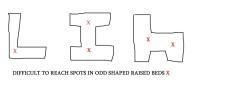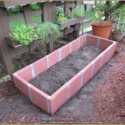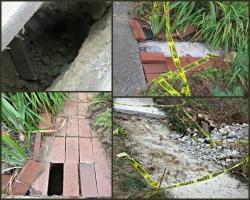The problem with odd shaped beds, such as your "keyhole" bed, is that they can potentially have areas that can be hard to get at, for maintenance or removing the plants (digging out the daylilies!!!) or harvesting or whatever else needs to be done. I found this out the hard way, when our landscape contractor had a landscape designer lay out my (ipe wood) raised beds. (The beds are roughly 22" high, and 3 - 3.5 ft interior width, with a 9" or so shelf atop the perimeter of the bed, as shown in the image below - convenient for resting tools and plants on, inconvenient in other ways.)

Yes, the irregular forms make for a more visually interesting garden than several plain rectangular beds - but each of those beds that has a "keyhole" (U-shaped indention, as in an "h" bed and some "I" beds) or turns a corner ("L" bed) has been a problem for me. Each of those beds has an area
X where it is hard to reach from the exterior of the bed (whereas if the beds were plain rectangles, all of the interior would be easy to reach, depending of course on the diameter of the bed).
(Perhaps it would be less of a problem for me if the raised beds were shorter, or if they did not have those ledges. I really prefer taller raised beds, for overall ease of work... but then, I am not climbing
into those beds. Raised beds where I know there will be relatively frequent turnover (such as my "new" seedling beds) are much shorter (so I can climb in, if needed), are rectangular in shape, and do not have ledges.)
Click on the image below to see all of the problematic raised bed shapes

... (Sorry that it is badly drawn and the beds are not scaled, but the red "X" roughly marks spots that are hard (for me) to get at from any part of the bed exterior.)

Apart from that caution (I hope your keyhole bed works out better for you than my beds have worked for me!), good job on recycling/repurposing and adding color and functionality to the garden! (And you clearly have a whole lot more patience than I do...

)




 Spring
Spring Problems - 2 sections of sidewalk removed; concrete from that area is in the hole - temporary - until completion.
Problems - 2 sections of sidewalk removed; concrete from that area is in the hole - temporary - until completion.